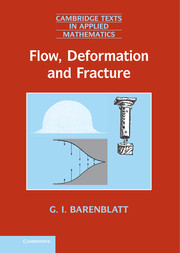Refine search
Actions for selected content:
8125 results in Fluid dynamics and solid mechanics
6 - The linear elastic solid approximation. Applications: brittle and quasi-brittle fracture; strength of structures
-
- Book:
- Flow, Deformation and Fracture
- Published online:
- 05 June 2014
- Print publication:
- 05 June 2014, pp 101-123
-
- Chapter
- Export citation

Flow, Deformation and Fracture
- Lectures on Fluid Mechanics and the Mechanics of Deformable Solids for Mathematicians and Physicists
-
- Published online:
- 05 June 2014
- Print publication:
- 05 June 2014
2 - Dimensional analysis and physical similitude
-
- Book:
- Flow, Deformation and Fracture
- Published online:
- 05 June 2014
- Print publication:
- 05 June 2014, pp 29-47
-
- Chapter
- Export citation
NEW DEVELOPMENT OF NONRIGID REGISTRATION
-
- Journal:
- The ANZIAM Journal / Volume 55 / Issue 3 / January 2014
- Published online by Cambridge University Press:
- 05 June 2014, pp. 289-297
-
- Article
-
- You have access
- Export citation
10 - The ideal gas approximation. Sound waves; shock waves
-
- Book:
- Flow, Deformation and Fracture
- Published online:
- 05 June 2014
- Print publication:
- 05 June 2014, pp 164-181
-
- Chapter
- Export citation
1 - Idealized continuous media: the basic concepts
-
- Book:
- Flow, Deformation and Fracture
- Published online:
- 05 June 2014
- Print publication:
- 05 June 2014, pp 10-28
-
- Chapter
- Export citation
4 - The ideal incompressible fluid approximation: analysis and applications
-
- Book:
- Flow, Deformation and Fracture
- Published online:
- 05 June 2014
- Print publication:
- 05 June 2014, pp 63-78
-
- Chapter
- Export citation
11 - Turbulence: generalities; scaling laws for shear flows
-
- Book:
- Flow, Deformation and Fracture
- Published online:
- 05 June 2014
- Print publication:
- 05 June 2014, pp 182-224
-
- Chapter
- Export citation
7 - The Newtonian viscous fluid approximation. General comments and basic relations
-
- Book:
- Flow, Deformation and Fracture
- Published online:
- 05 June 2014
- Print publication:
- 05 June 2014, pp 124-136
-
- Chapter
- Export citation
9 - Advanced similarity methods: complete and incomplete similarity
-
- Book:
- Flow, Deformation and Fracture
- Published online:
- 05 June 2014
- Print publication:
- 05 June 2014, pp 150-163
-
- Chapter
- Export citation
12 - Turbulence: mathematical models of turbulent shear flows and of the local structure of turbulent flows at very large Reynolds numbers
-
- Book:
- Flow, Deformation and Fracture
- Published online:
- 05 June 2014
- Print publication:
- 05 June 2014, pp 225-242
-
- Chapter
- Export citation
5 - The linear elastic solid approximation. Basic equations and boundary value problems in the linear theory of elasticity
-
- Book:
- Flow, Deformation and Fracture
- Published online:
- 05 June 2014
- Print publication:
- 05 June 2014, pp 79-100
-
- Chapter
- Export citation
Foreword
-
- Book:
- Flow, Deformation and Fracture
- Published online:
- 05 June 2014
- Print publication:
- 05 June 2014, pp xi-xii
-
- Chapter
- Export citation
HOPF BIFURCATION ANALYSIS FOR A RATIO-DEPENDENT PREDATOR–PREY SYSTEM INVOLVING TWO DELAYS
- Part of
-
- Journal:
- The ANZIAM Journal / Volume 55 / Issue 3 / January 2014
- Published online by Cambridge University Press:
- 05 June 2014, pp. 214-231
-
- Article
-
- You have access
- Export citation

Fundamentals and Applications of Micro- and Nanofibers
-
- Published online:
- 05 June 2014
- Print publication:
- 08 May 2014
8 - The Newtonian viscous fluid approximation. Applications: the boundary layer
-
- Book:
- Flow, Deformation and Fracture
- Published online:
- 05 June 2014
- Print publication:
- 05 June 2014, pp 137-149
-
- Chapter
- Export citation
MEMBRANE-COUPLED GRAVITY WAVE SCATTERING BY A VERTICAL BARRIER WITH A GAP
- Part of
-
- Journal:
- The ANZIAM Journal / Volume 55 / Issue 3 / January 2014
- Published online by Cambridge University Press:
- 05 June 2014, pp. 267-288
-
- Article
-
- You have access
- Export citation
Subject Index
-
- Book:
- Fundamentals and Applications of Micro- and Nanofibers
- Published online:
- 05 June 2014
- Print publication:
- 08 May 2014, pp 432-443
-
- Chapter
- Export citation
6 - Additional methods and materials used to form micro- and nanofibers
-
- Book:
- Fundamentals and Applications of Micro- and Nanofibers
- Published online:
- 05 June 2014
- Print publication:
- 08 May 2014, pp 262-296
-
- Chapter
- Export citation
5 - Electrospinning of micro- and nanofibers
-
- Book:
- Fundamentals and Applications of Micro- and Nanofibers
- Published online:
- 05 June 2014
- Print publication:
- 08 May 2014, pp 179-261
-
- Chapter
- Export citation
